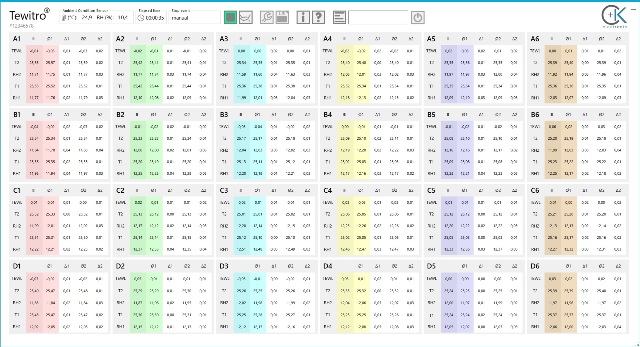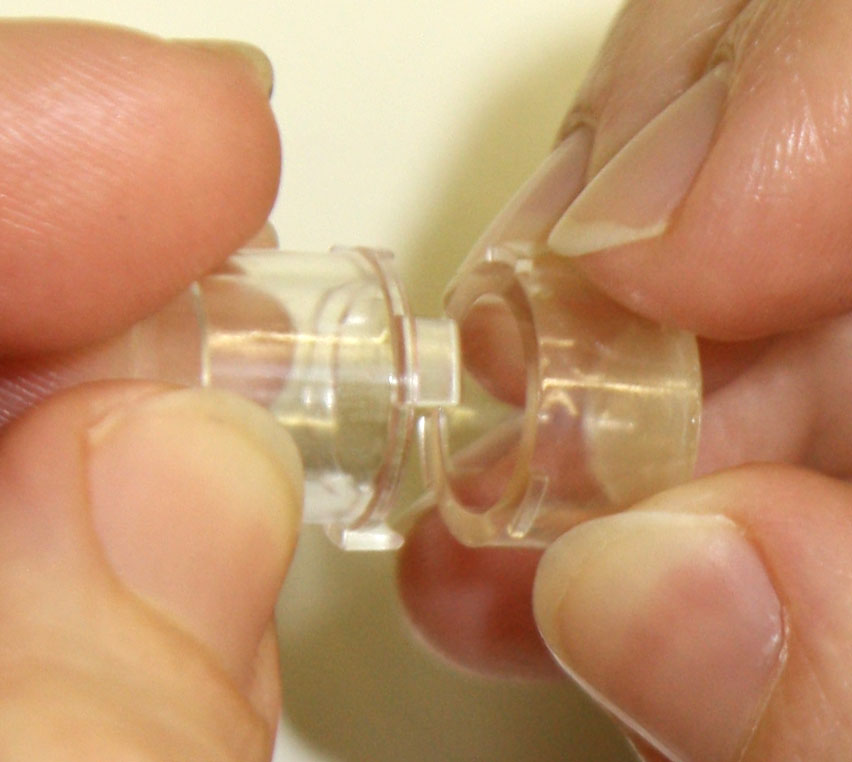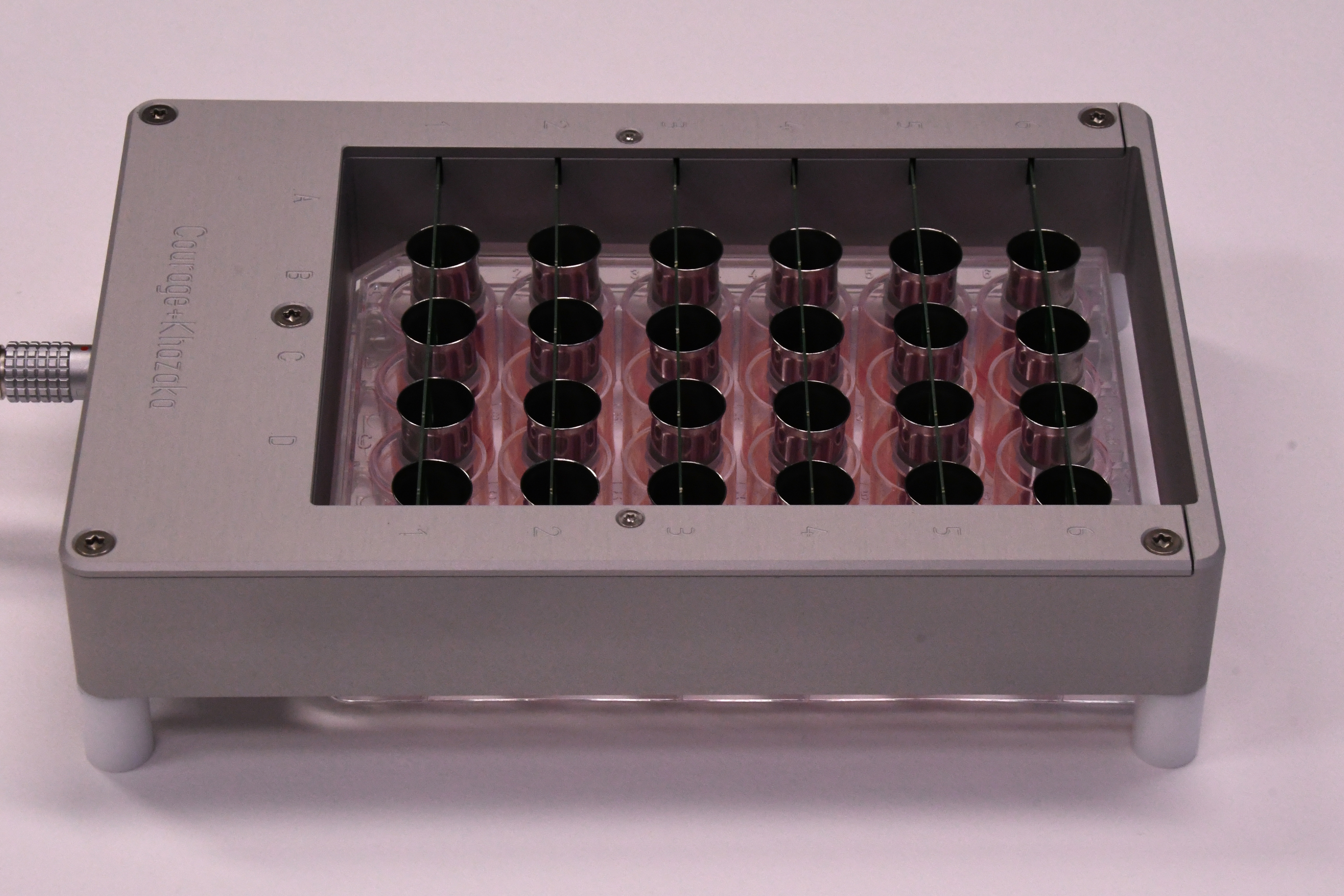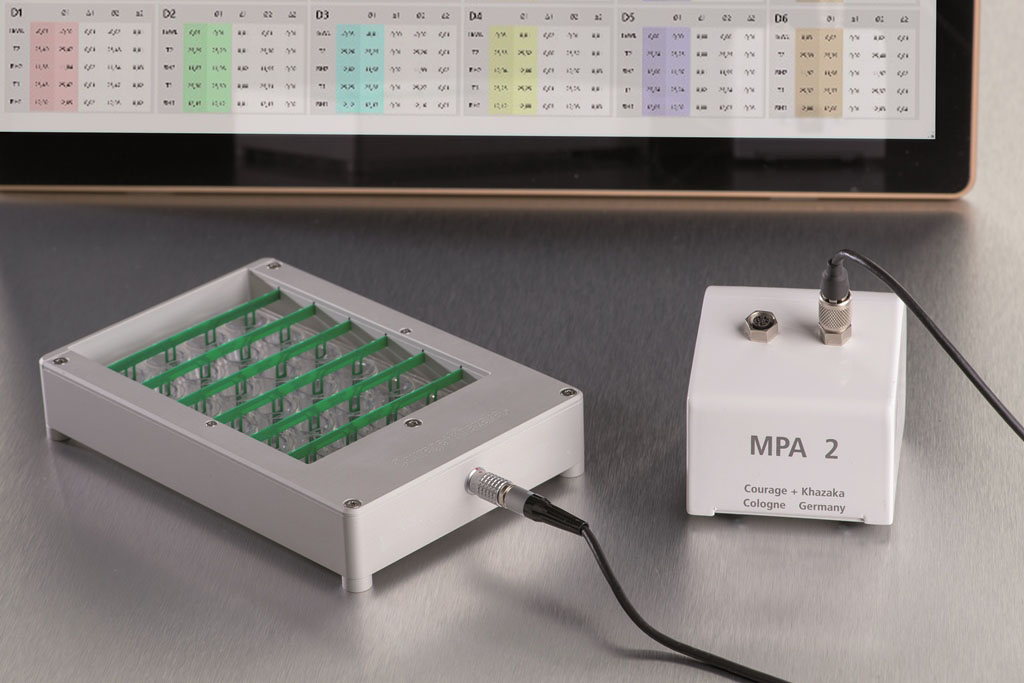Courage + Khazaka electronic GmbH
Tewitro TW 24 Transepidermal Waterloss Measurement in Skin Tissue Models
Tewitro TW 24 Transepidermal Waterloss Measurement in Skin Tissue Models
Transepidermal Waterloss Measurement in Skin Tissue Models
The Tewitro® TW 24 is the only device to measure the water evaporation from cultured tissue sets (wells in a plate with medium) in up to 24 wells simultaneously with the worldwide most used “open chamber” measurement of the Tewameter®.
Fields of Application
For each product to be applied to the skin, safetymeasurements are indispensable. The use of skin tissue models for long-term safety tests is a quick and easy method to avoid using animals or volunteers.
- It is the only way to study skin permeability and dermal absorption necessary for safety and efficacy testing
- In vitro tests and procedures to minimize the use of animals in tests are established in several worldwide acknowledged guidelines: e.g. ECVAM (European Centre for the Validation of Alternatives to Animal Testing), OECD (Organisation for Economic Co-operation and Development) or REACH (Registration, Evaluation, Authorisation and Restriction of Chemicals)
Whenever the barrier is damaged, the evaporation rate will increase immediately. Also for claims related to barrier improvement/enhancing, tests on cultured cells are needed, as products meant to keep the barrier intact or to even improve it, can be detected by a stable Transepidermal Water Loss (TEWL).
The Tewitro® is well-suited to non-invasively monitor TEWL of cultured skin tissue samples. These results open up new opportunities to monitor the dermal barrier physiology under different experimental conditions and treatments in vitro.
Tewitro® Measurement Principle
Fully equipped, the Tewitro® TW 24 can be used in standard 24-wells plates (6x4). The probe features 6 slots with 4 measurement inlets each, but is also available as single rows of 1 slot with 4 measuring inlets (respectively for 8, 12, 16 or 20 inlets), depending on the used well plate size. Each measurement inlet features two sensor pairs constantly measuring temperature and relative humidity, thus measuring in an indirect way the density gradient of the water evaporation from the surface of the bottom of the well. This gradient equals the Transepidermal Water Loss typically measured on the in vivo skin surface in g/h/m². This "open chamber" TEWL measurement method is the worldwide most-used method to quantify the barrier function of the skin. Hundreds of publications prove this fact. The Tewameter® had even been used on board of the International Space Station (ISS) to monitor the astronaut's skin during long-term exposure in space.
Software
- The convenient and organized software offers 24 TEWL-values (one for each measurement inlet), with two different adjustable averages and their respective standard deviations as well as the possibility of displaying and saving the RH and temperature value for the upper and lower sensor pair for each measurement inlet (2 x 24) separately.
- Graphical view for each measurement inlet with one click
- Measurements from a couple of seconds up to 24 h long-term studies are possible.
- Automatic stop conditions for the measurement (stability of the measurement or time)
- Warning displayed, if RH exceeds the range for regular measurement uncertainty.
- Easy & quick check calibration and offset
- If the Ambient Condition Sensor probe is connected, its values are constantly recorded during the measurement and saved with the results.



Use on In Vitro Tissue Models
The Tewitro® TW 24 can measure in the well plates of cultured tissue. Until now, we have experience with the following readily on the market available models:
- Lab cyte (www.labcyte.com), EPI-MODEL® 24, a product of the Corning "Falcon" series and
- Episkin® products Skin Ethic® RHE and RHPE
- 8 mm, 0.5 cm2 (www.episkin.com/en/SkinEthic-RHE) – with additional adapters
- Mattek Epiderm® 24 wells set (www.mattek.com) – with additional adapters

Tewitro® TW 24R
The Tewitro® TW 24R has been developed to allow TEWL measurements on full thickness reconstructed epidermis. This probe has slightly higher feet and is delivered with stainless steel diffusion tubes.
Example:![]() Phenion® FT (https://www.phenion.com) by Henkel directly in the wells.
Phenion® FT (https://www.phenion.com) by Henkel directly in the wells.




For other models, please check with us by providing a sample. The probe can be custom fitted to many different systems (ask for a price offer).
For the measurement of TEWL, the plate with the wells and the measurement probe has to be heated to skin temperature. The laboratory condition is rather cool (20-22°C), in this condition differences in TEWL are barely visible. As soon as the system is heated to skin temperature, the differences become immediately obvious. We recommend to use a heating plate with a temperature around 33 °C.
Typical Application Examples
On pre-cultured tissue before the product(s) to be tested are applied:
Constant measurement of the evaporating water which is typical for the wells when coming out of the incubator until a normal TEWL value (for incubated cell cultures) is reached. When the probe starts to measure, the TEWL is very high but constantly decreasing. As soon as it has reached a stable plateau, it indicates that the tissue cultures are now ready for the application of the product. At the same time, the recorded TEWL is a control value (before application).
Benefits:- The probe can constantly measure over longer periods (only possible with open chamber measurements).
- The measurement shows that all tissue cultures are ok (quality check).
- The software can indicate that the TEWL has reached a stable threshold value.
- You can be sure to apply the tested products in repeated tests to tissue cultures under the same conditions.
- Control value of all wells used is recorded before application, so that the later measured effects can be surely attributed to the product.
Measuring the actual effect on the barrier function of applied products (safety & efficacy):
When the well-plate comes out of the incubator, the TEWL measurement can again be used to monitor when the surplus humidity from the incubator has left the samples and the real measurement time starts. Depending on the nature of the applied products the barrier of the cultured tissues is more or less intact. When the barrier has been damaged, particles of the cells can be found (microbiologically) in the surrounding medium. However, the degree of damage or barrier improvement can very accurately be indicated by the monitored TEWL- values. The higher they stay, the less intact the barrier.
Additional Benefits:
- The micro climate in the wells, once they are out of the incubator, is constantly changing. After leaving the incubator, the cultured tissues also dry quickly and shrink soon. Therefore, to get meaningful results, it is important to measure all wells at the same time/same conditions and not miss the correct measurement point. If you perform single measurements in each well one after the other, the values will never be comparable. For 24 wells such a procedure would take way too long to get reproducible results.
- Extremely time- (and manpower-) saving and economic.
- The open chamber TEWL measurement do not inhibit the normal evaporation rate and does not cause occlusion.
Share






